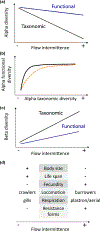A global perspective on the functional responses of stream communities to flow intermittence
- PMID: 34720401
- PMCID: PMC8554635
- DOI: 10.1111/ecog.05697
A global perspective on the functional responses of stream communities to flow intermittence
Abstract
The current erosion of biodiversity is a major concern that threatens the ecological integrity of ecosystems and the ecosystem services they provide. Due to global change, an increasing proportion of river networks are drying and changes from perennial to non-perennial flow regimes represent dramatic ecological shifts with potentially irreversible alterations of community and ecosystem dynamics. However, there is minimal understanding of how biological communities respond functionally to drying. Here, we highlight the taxonomic and functional responses of aquatic macroinvertebrate communities to flow intermittence across river networks from three continents, to test predictions from underlying trait-based conceptual theory. We found a significant breakpoint in the relationship between taxonomic and functional richness, indicating higher functional redundancy at sites with flow intermittence higher than 28%. Multiple strands of evidence, including patterns of alpha and beta diversity and functional group membership, indicated that functional redundancy did not compensate for biodiversity loss associated with increasing intermittence, contrary to received wisdom. A specific set of functional trait modalities, including small body size, short life span and high fecundity, were selected with increasing flow intermittence. These results demonstrate the functional responses of river communities to drying and suggest that on-going biodiversity reduction due to global change in drying river networks is threatening their functional integrity. These results indicate that such patterns might be common in these ecosystems, even where drying is considered a predictable disturbance. This highlights the need for the conservation of natural drying regimes of intermittent rivers to secure their ecological integrity.
Keywords: biodiversity loss; fragmentation; global change; life-history traits; temporary rivers.
Figures



References
-
- Acuña V. et al. 2014. Why should we care about temporary waterways? – Science 343: 1080–1081. - PubMed
-
- Archer LC et al. 2020. Food and temperature stressors have opposing effects in determining flexible migration decisions in brown trout Salmo trutta. – Global Change Biol. 26: 2878–2896. - PubMed
-
- Arce MI et al. 2019. A conceptual framework for understanding the biogeochemistry of dry riverbeds through the lens of soil science. – Earth-Sci. Rev 188: 441–453.
-
- Arscott DB et al. 2010. Aquatic invertebrate community structure along an intermittence gradient: Selwyn River New Zealand. – J. N. Am. Benthol. Soc 29: 530–545.
-
- Aspin TWH et al. 2018. Drought intensification drives turnover of structure and function in stream invertebrate communities. – Ecography 41: 1992–2004.
Associated data
Grants and funding
LinkOut - more resources
Full Text Sources
Other Literature Sources
